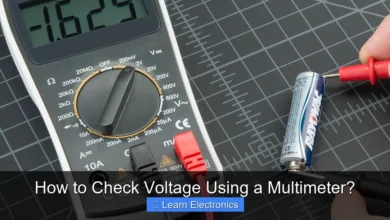How to Figure out Amps?

As an Amazon Associate, I earn commission from qualifying purchases.
To figure out amps, you generally need to know the voltage and either the resistance or power of an electrical circuit or device. This process is fundamental in electronics and essential for safety and efficiency. Understanding this technique allows you to properly size wiring, troubleshoot circuits, and ensure components operate within their limits.
Quick Answers to Common Questions
How can I quickly figure out amps if I know my device’s wattage and voltage?
The simplest way to figure out amps is by using the formula: Amps = Watts / Volts. Just divide the device’s wattage by your system’s voltage, and you’ll have the amps!
Why is knowing how to figure out amps so important for my electrical projects?
Understanding how to figure out amps helps you choose the right wire gauges and circuit breakers, preventing overloads and ensuring electrical safety for all your projects. It’s crucial for keeping things running smoothly and safely!
What if I don’t know the wattage but I know voltage and resistance? Can I still figure out amps?
Absolutely! You can still figure out amps using Ohm’s Law: Amps = Volts / Ohms (Resistance). This formula is super handy when you’re working with components where resistance is known.
📑 Table of Contents
Understanding the Fundamentals of Electricity
Before diving into calculations, it’s crucial to grasp the basic concepts of electricity. Think of electricity like water flowing through a pipe. Each element plays a distinct role in how that “flow” behaves.
What are Amps (Current), Volts (Voltage), and Watts (Power)?
- Amperes (Amps/A): This is the measure of electrical current, representing the rate of flow of electrons through a conductor. In our water analogy, amps are like the volume of water flowing through the pipe per second. A higher amp rating means more electrons are flowing.
- Volts (Voltage/V): This is the measure of electrical potential difference or electromotive force. It’s the “push” or “pressure” that causes electrons to flow. In the analogy, voltage is akin to the water pressure in the pipe. Higher voltage means a stronger push.
- Ohms (Resistance/Ω): This measures the opposition to the flow of electric current. It’s like the narrowness or friction inside the pipe that restricts water flow. Higher resistance means less current can flow for a given voltage.
- Watts (Power/W): This is the measure of the rate at which electrical energy is consumed or produced. It represents the actual work being done by the electricity. In the analogy, watts are like the power of the water hitting a turbine to generate energy. Power is directly related to both voltage and current.
The Relationship: Ohm’s Law and the Power Formula
These electrical quantities are not independent; they are governed by fundamental laws:
- Ohm’s Law: This law describes the relationship between voltage, current, and resistance. It’s typically expressed as:
V = I × RWhere:
Vis Voltage (Volts)Iis Current (Amperes)Ris Resistance (Ohms)
- The Power Formula: This formula relates power to voltage and current:
P = V × IWhere:
Pis Power (Watts)Vis Voltage (Volts)Iis Current (Amperes)
How to Figure Out Amps Using Formulas
The most common way to determine amperage without direct measurement is by using the two fundamental formulas mentioned above. This technique is invaluable for design, troubleshooting, and understanding device requirements.
Using Ohm’s Law (I = V/R)
If you know the voltage (V) across a component or circuit and its resistance (R), you can easily calculate the current (I).
Formula: I = V / R
Example: A simple circuit has a 12-volt battery and a resistor with a resistance of 4 ohms.
I = 12 V / 4 Ω = 3 Amps
So, 3 amps of current will flow through the circuit.
Using the Power Formula (I = P/V)
Often, you’ll know a device’s power consumption (in watts) and the voltage it operates on (e.g., 120V for household outlets, 240V for large appliances). With this information, you can find the current.
Formula: I = P / V
Example: A 60-watt light bulb is connected to a standard 120-volt household outlet.
I = 60 W / 120 V = 0.5 Amps
The light bulb draws 0.5 amps of current.
Practical Examples for Formula Application
Let’s consider a few real-world scenarios:
- Charging a Phone: A phone charger might be rated for 10 watts at 5 volts output. Using
I = P / V, the output current is10 W / 5 V = 2 Amps. - Heating Element: An electric kettle rated at 1500 watts operating on a 120-volt supply. The current drawn would be
1500 W / 120 V = 12.5 Amps. This high amperage explains why kettles often require dedicated circuits or can trip breakers if other high-power devices are on the same circuit. - Car Headlights: A pair of car headlights might have a total resistance of 3 ohms and operate on a 12-volt car battery. Using
I = V / R, the current is12 V / 3 Ω = 4 Amps.
Practical Tools and Methods for Measuring Amps
While formulas are great for calculations and predictions, sometimes you need to know the actual current flowing in a live circuit. This is where specialized tools come into play.
Multimeters and Clamp Meters
- Multimeter: A versatile tool that can measure voltage, resistance, and current (among other things). To measure current with a multimeter, it must be connected in series with the circuit, meaning the current has to flow through the meter. This requires breaking the circuit, which can be inconvenient and sometimes dangerous.
- Clamp Meter (or Clamp-On Ammeter): This tool measures current by detecting the magnetic field created by the current flowing through a wire, without needing to break the circuit. You simply clamp the jaws around a single conductor. This makes it much safer and easier for live circuit measurements.
How to Safely Use a Clamp Meter
- Select the Right Setting: Set the clamp meter to the appropriate current measurement range (e.g., AC amps for household current, DC amps for batteries/automotive).
- Isolate a Single Conductor: The clamp must go around only one current-carrying wire (e.g., the hot wire or the neutral wire, but not both at once, as the magnetic fields would cancel out).
- Clamp and Read: Securely clamp the jaws around the wire. The display will show the current in amperes.
Always ensure your hands are dry, and consider wearing insulating gloves, especially when working with live circuits.
When to Use a Multimeter for Current Measurement
While clamp meters are convenient for AC current, multimeters are often preferred for low DC current measurements or when precise readings in a controlled environment are needed. Remember, to measure current with a multimeter:
- Turn off the Power: ALWAYS de-energize the circuit before connecting a multimeter in series.
- Connect in Series: Open the circuit where you want to measure current. Connect the multimeter’s leads so that the current flows through the meter (e.g., disconnect a wire, connect one multimeter lead to the power source side, and the other lead to the component side).
- Select Amps Setting: Choose the appropriate current range (e.g., mA for milliamps, A for amps).
- Restore Power and Read: Carefully re-energize the circuit and read the measurement. Then, de-energize again before disconnecting the meter and restoring the circuit.
Incorrectly connecting a multimeter (e.g., in parallel across a voltage source while in current mode) can damage the meter and potentially create a short circuit.
Common Scenarios and Considerations for Amperage
Understanding current is critical in various everyday and specialized applications.
Household Appliances and Circuit Breakers
Every household appliance has an amperage draw. Knowing this helps prevent overloading circuits. Circuit breakers are designed to trip (open the circuit) if the current exceeds a safe limit (e.g., 15 amps or 20 amps for common household circuits), preventing overheating of wires and potential fires.
For example, if you plug in a vacuum cleaner (10 Amps), a microwave (12 Amps), and a toaster (8 Amps) into outlets on the same 15-amp circuit, the total draw (30 Amps) would immediately trip the breaker. This is a common way to figure out amps in practice, by seeing what trips the breaker.
Automotive Applications
In cars, current draw is essential for battery health and fuse protection. Fuses are rated in amps and protect specific components (e.g., radio, headlights) from drawing too much current, which could damage the component or wiring. An understanding of this practice helps in diagnosing electrical issues like parasitic drains (components drawing current even when the car is off).
Device Specifications and Labels
Most electrical devices come with labels indicating their power consumption (watts) and voltage requirements. From these, you can easily calculate the amperage. Look for terms like “Input: 120V~ 1.5A” or “Power: 180W”. If only power and voltage are given, use the I = P / V formula.
Calculating Amps for Circuit Design and Safety
Whether you’re building a new circuit or modifying an existing one, knowing how to figure out amps for proper component selection is paramount for safety and optimal performance.
Sizing Wires and Fuses
Wires have a maximum current carrying capacity, specified by their gauge (thickness). Thinner wires have higher resistance and can only safely carry less current before overheating. Fuses are protective devices with a specific amperage rating, designed to melt and break the circuit if the current exceeds that rating. Always select wires and fuses that can safely handle the expected maximum current draw of your circuit, with a safety margin.
Series vs. Parallel Circuits
- Series Circuits: In a series circuit, the current is the same through every component. The total resistance is the sum of individual resistances (
R_total = R1 + R2 + ...). The total current is calculated using Ohm’s Law with the total resistance and the source voltage. - Parallel Circuits: In a parallel circuit, the voltage across each component is the same, but the current splits. The total current drawn from the source is the sum of the currents through each individual branch (
I_total = I1 + I2 + ...). Each branch’s current can be calculated using Ohm’s Law (I = V / R) for that branch.
Understanding this distinction is vital when designing and troubleshooting electrical systems, as it directly impacts how current flows and distributes.
Safety Precautions When Working with Electricity
Electricity can be dangerous. Always prioritize safety:
- Turn off Power: Before working on any circuit, always disconnect the power source.
- Use Insulated Tools: Ensure your tools have insulated handles.
- Wear PPE: Safety glasses and insulated gloves are recommended.
- Never Work Alone: Have someone nearby who can assist in an emergency.
- Verify with a Voltmeter: Always use a voltmeter to confirm that a circuit is de-energized before touching it.
- Understand the Circuit: Never guess. Always have a clear understanding of the circuit you are working on.
Data Table: Typical Amperage for Common Devices
The following table provides approximate amperage draw for common household devices operating on a 120V AC supply. Actual values may vary based on specific models and power settings.
| Device | Approximate Power (Watts) | Approximate Amperage (120V AC) |
|---|---|---|
| LED Light Bulb (100W equivalent) | 10-15 W | 0.08 – 0.13 A |
| Laptop Charger | 45-90 W | 0.38 – 0.75 A |
| Flat-screen TV (40-50 inch) | 50-150 W | 0.42 – 1.25 A |
| Refrigerator (running) | 150-400 W | 1.25 – 3.33 A |
| Microwave Oven | 600-1500 W | 5.0 – 12.5 A |
| Coffee Maker | 800-1200 W | 6.67 – 10.0 A |
| Hair Dryer | 1200-1875 W | 10.0 – 15.63 A |
| Electric Kettle | 1200-1500 W | 10.0 – 12.5 A |
| Vacuum Cleaner | 1000-1440 W | 8.33 – 12.0 A |
| Window Air Conditioner (10,000 BTU) | 1000-1200 W | 8.33 – 10.0 A |
Conclusion
Mastering the ability to figure out amps is a foundational skill in electronics, whether you’re a hobbyist, a professional, or simply trying to understand your home’s electrical system. By understanding Ohm’s Law and the Power Formula, along with the safe and proper use of tools like multimeters and clamp meters, you gain the knowledge to analyze, design, and troubleshoot electrical circuits effectively.
Always remember that working with electricity demands respect and adherence to safety protocols. With the insights provided in this guide, you’re well-equipped to approach electrical challenges with confidence and precision, ensuring both efficiency and safety in your endeavors.
Frequently Asked Questions
What are amps and why do I need to figure them out?
Amps, or amperes, measure the electrical current flowing through a circuit. Knowing the amperage is crucial for safety and functionality, as it helps you determine if a circuit can handle a device’s power requirements without overloading. It also aids in selecting appropriate wire gauges and circuit breakers for your electrical system.
How do I figure out the amps of an appliance I already own?
For most appliances, the amperage (A) or wattage (W) is listed on a label, nameplate, or in the user manual. If only wattage is provided, you can use Ohm’s Law to calculate the amps: Amps = Watts / Volts. For household items, assume 120V for standard outlets in many regions, or 240V for larger appliances.
What tools can help me figure out the amps in a live circuit?
To measure the actual current in a live circuit, you’ll primarily need a multimeter with an amperage function or, more commonly and safely for higher currents, a clamp meter. A clamp meter allows you to measure amps without breaking the circuit, simply by clamping around one of the circuit wires. Always exercise extreme caution and follow safety guidelines when working with live electricity.
How can I estimate the amps needed for a new project or device?
If you’re designing a new circuit or building a custom device, you can estimate the amps by adding up the current draw of individual components, often found in their specification sheets. When planning, it’s wise to include a safety margin and account for potential peak loads to ensure your circuit can handle the maximum required amps without issues.
How do volts, watts, and amps relate to each other?
These three fundamental electrical units are interconnected through the power formula: Watts (power) = Volts (voltage) x Amps (current). This means if you know any two of these values, you can easily figure out the third. For example, knowing a device’s wattage and the voltage of your outlet allows you to calculate the amps it will draw.
What are common reasons I might need to figure out amps for safety?
Understanding amps is vital for preventing electrical overloads, which can lead to tripped breakers, damaged appliances, or even fires. You need to figure out amps to ensure your circuit breakers are correctly rated, to select the appropriate wire gauge for new circuits, or when troubleshooting why a circuit frequently trips. It helps ensure your entire electrical system operates safely within its designed limits.



